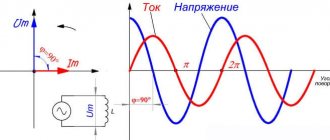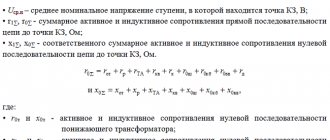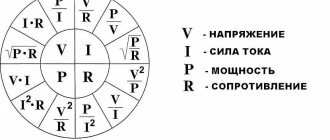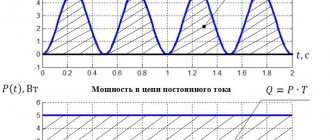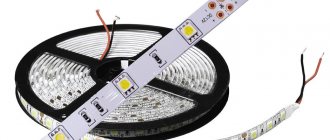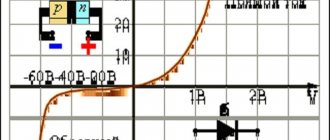Errors when calculating V•A
The ratios of volt amperes and watts for certain types of electrical appliances and devices, for example, light bulbs, are identical. But when talking about computers, watts and V•A will be different, but V•A will always be greater than or equal to watts. The gap is related to power factor (PF), which varies among devices. If you do not take it into account, then when selecting equipment elements an error will be made and they will not fit the main device.
If we consider the choice of a UPS for a personal computer, and on the passport data the rating is indicated in voltamper, this will make it difficult to select a rating in W. When there are no exact indicators of P, do the following - the load data indicated on the nameplate is taken equal to 60% of the V•A indicator of the UPS.
You may be interested in this Insulation measurement
Online calculator
Additional Information. In order to more accurately determine the data, you can use an online calculator. Some websites provide the user with the required P if they click on the device type, such as TV or desktop. These sites often show graphical charts that make it easy to measure the V•A of various appliances, from refrigerators to computers.
It can be concluded that V•A is an important characteristic for modern electrical devices and equipment. If this indicator is not taken into account when purchasing electrical devices, they will operate in overload mode, which will lead to their premature failure.
What else affects the performance of electronic devices?
Much depends on the type of battery - most electronic gadgets today have a lithium-ion battery, which can be charged without waiting for complete discharge.
Moreover, hardware also affects performance: the more powerful the phone, the more mA should be in the battery. For example, one gadget with a 1550 mAh battery can work for 5 days without recharging, while another with a 3500 mAh battery will not last even a day.
The display is also a big energy consumer. The secret here is in the screen production technology. IPS will require more power than Super AMOLED, which is very energy efficient due to the predominant black color on the screen. Don't write off brightness and resolution.
It is important that your phone has as few unnecessary background processes and services enabled as possible. Fortunately, devices from Sony and Samsung include special utilities in the software that optimize the operation of the device and save energy.
And that’s not all: don’t forget about the heart of any electronic gadget – the processor, which also loves to “eat well”.
It turns out that this is not so important if you take a closer look at the other characteristics. Therefore, when buying a new device, you should pay attention not only to the battery, but also to the hardware, software and screen type.
How to convert volts and watts and vice versa
To correctly complete the task associated with converting volts to watts, you can follow the following algorithm:
- You need to find the power value in the operating manual of the electrical appliance. Companies often indicate this value in volt-amperes. This symbol indicates the maximum amount of electricity consumed. So it is equal to the power value.
- Determine the efficiency of the power source based on the design features and the number of devices connected to it. As a rule, this coefficient is set in the range from 0.6 to 0.8.
- Convert current-voltage indicators to W: find out the active power of energy equipment designed to supply uninterruptible power.
You may be interested in Determining the current or voltage in an outlet
Important! Calculate the number of watts by multiplying volt-amperes by efficiency.
Visual representation of voltage and current
- Conversion from W to V follows the reverse pattern: watts must be divided by the efficiency factor.
When choosing a power source from the manufacturer, it is not always clear how much power the device produces. Therefore, it is recommended to study the technical parameters specified in the instructions in order to carry out the correct conversion from one value to another.
How many watts are in 1 ampere?
Now let's try to convert Watts to Amps.
And for this we need one more formula: In it, I is A, P is Watt, and U is Volt.
By making a simple calculation using this formula, we can find out how many Watts are in one A.
As we said earlier, there is another way to calculate how many watts are in 1 A. In order to use it, you will need to open an online calculator
and enter the power consumption as well as the voltage into it.
Next, you just need to click on the button labeled “calculate” and within a couple of seconds a special program will give you the correct value. By using this method, you will undoubtedly be able to save your time and effort, since you do not have to independently calculate all the indicators using formulas.
1 Volt is equal to the electrical voltage that causes a direct current of 1 ampere at a power of 1 watt in an electrical circuit.
Volt
(symbol:
V
,
V
) is a unit of measurement of electrical voltage in the SI system.
1 Volt is equal to the electrical voltage that causes a direct current of 1 ampere at a power of 1 watt in an electrical circuit.
Volt (V, V) can be defined either as the electrical voltage at the ends of a conductor required to generate one watt (W, W) of heat in it when a direct current of one ampere (A) flows through that conductor, or as the difference potentials between two points of the electrostatic field, when passing over a charge of 1 coulomb (C, C), work of 1 joule (J, J) is performed. Expressed in SI base units, one volt is equal to m2 kg s −3 A −1.
\
The unit is named after the Italian physicist and physiologist Alessandro Volta.
By this method, the value of a volt is unambiguously associated with the frequency standard set by a cesium clock: when a matrix consisting of several thousand Josephson junctions is irradiated with microwave radiation at frequencies from 10 to 80 GHz, a well-defined electrical voltage arises, with the help of which voltmeters are calibrated. Experiments have shown that this method is insensitive to the specific implementation of the installation and does not require the introduction of correction factors.
1 V = 1/300 units. SGSE potential.
What is Volt. Definition
A volt is defined as the potential difference across the ends of a conductor that dissipates one watt of power when the current through that conductor is one ampere.
From here, based on SI units, we get m² kg s-3 A-1, which is equivalent to joule of energy per coulomb of charge, J/C.
Definition based on the Josephson effect
The voltage of an electric current is a value that characterizes the difference in charges (potentials) between the poles or sections of the circuit through which the current flows.
Since 1990, the volt has been standardized by measurement using the time-dependent Josephson effect, which uses the Josephson constant as a reference to the standard, fixed by the 18th General Conference on Weights and Measurement as:
K{J-90} = 0.4835979 GHz/μV.
Multiples and submultiples
Decimal multiples and submultiples are formed using standard SI prefixes.
In accordance with the SI rules concerning derived units named after scientists, the name of the unit volt is written with a lowercase letter, and its designation is written with a capital letter. This spelling of the designation is also preserved in the designations of derived units formed using the volt. For example, the designation of the unit of measurement of electric field strength “volt per meter” is written as V/m.
Voltage scale
- The potential difference across the neuron membrane is 70 mV.
- NiCd battery - 1.2 V.
- Alkaline cell - 1.5 V.
- Lithium iron phosphate battery (LiFePO 4) - 3.3 V.
- Battery "Krona" - 9 V.
- Car battery - 12 V (for heavy trucks - 24 V).
- Household voltage is 220 V (rms).
- The voltage in the contact network of a tram and trolleybus is 600 V.
- Electrified railways - 3 kV (direct current), 25 kV (alternating current).
- Main power lines - 110 kV, 220 kV.
- The maximum voltage on power lines (Ekibastuz-Kokchetav) is 1.15 MV.
- The highest DC voltage obtained in the laboratory using a pelletron is 25 MV.
- Lightning - from 100 MV and above.
Javascript is disabled in your browser. To perform calculations, you must enable ActiveX controls!
What is Current Strength. Ampere [A]
Current strength is a physical quantity equal to the ratio of the amount of charge flowing through a conductor over a certain period of time to the value of this same period of time. Measured in Amperes.
1 Ampere contains:
- 1,000,000 microamps
- 1,000 milliamps
Sometimes such a task as converting amperes to watts or kilowatts, or vice versa - watts and kilowatts to amperes, can be difficult. After all, rarely do any of us remember the formulas from school by heart. Unless, of course, you constantly have to deal with this due to your profession or hobby.
In fact, in everyday life knowledge of such things may be required quite often. For example, on the socket or plug there is a marking in the form of the inscription: “220V 6A”. This marking reflects the maximum permissible power of the connected load. What does it mean? What is the maximum power of a network device that can be plugged into such an outlet or used with this plug?
What is the difference between W and V (V and A)
What is the difference between a volt and an ampere: Volt is a unit of measurement of voltage, and watt is a unit of power. V is the difference created in the electrical potential across a wire line when a current of 1A dissipates a unit of power, i.e. voltage. The definition of voltage is that it is the potential of electricity between different points. Along with this, it is used to indicate the difference in potential energy of an electric charge between points. An energy source is a voltage that represents expended or lost energy.
About power
Attention! Voltage is hypothetically similar to the pressure created in a circuit, pushing electrons through.
The passage of current must be ensured on two paths. This characteristic is considered the total energy for moving the charge. The definition of voltage is based on the fact that negative charges are attracted to high values, and positive charges to low values.
W – speed of work. The speed is maintained at 1 meter per second against a constant reaction force of 1 newton. If we consider it in relation to electromagnetism, the unit is the rate of work done when 1 ampere passes through a potential difference of 1V. Watt is a measure of power.
You may be interested in this Features of the DRL 250 lamp
Power
Power is the energy flow with which energy is consumed. It happens that in the description of a device it appears instead of kW - kVA. To determine this value, you need to know what is measured in kVA.
No energy is expended to complete the work, but on the contrary:
- One of the factions becomes active, that is, it performs work or transforms into another form.
- The other faction is reactive. The energy is directed into an electromagnetic field.
Attention! These quantities are different, despite the same proportionality. To avoid confusion, the indicator is measured not in watts, but in volt-amperes.
Mechanical power
How to choose a battery for a smartphone
Today, many batteries have a charge controller, which in an emergency (overheating, hypothermia of the battery) will turn off the device. This is great, but when buying a battery, you should focus not only on the controller, and not even on the capacity (however, the more mAh, the better), but on:
- identical to the old battery; Voltage also matters (on average it is 3.7 V);
- battery type (lithium-ion or other);
- warranties (standard - from six months to three years);
- number of times to charge the battery (usually 1000 times);
- strength;
- cost (you won’t be able to buy a high-capacity battery for little money: either the seller is trying to deceive, and the battery is of poor quality, or the capacity is lower than specified).
It should also be remembered that charging the battery too often can cause rapid wear.
The article discussed what this means - mAh. We hope the information was useful.
What does 10000 mAh battery mean?
But the real find was external batteries (Power Bank) with a similar capacity, which will become a lifesaver for every traveler when there are no outlets nearby and the volume of the original battery is small.
While some Power Banks can only charge a couple of smartphones, others can easily handle tablets, laptops and digital cameras). Accordingly, more powerful devices are those with a battery of 20,000 mAh or higher.
The capacity of external batteries is measured in the same milliamp-hours. This parameter determines how many times the device can charge a smartphone or other device. But even if the Power Bank indicates a capacity of 10,000 mAh, then in reality it is less, and in small letters it is written that in fact its capacity is less. As a rule, 10,000 mAh is 30%, which is “lost” as a result of voltage conversion. The range of gadgets with a powerful battery – 10,000 mAh and higher – is becoming wider.


